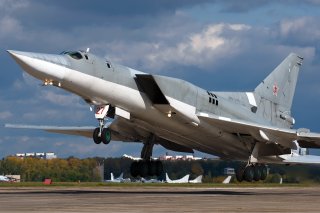Russian Tu-22M3 Bombers Armed With Hypersonic Missiles Head to Syria
One of six advanced weapons unveiled by Russian president Vladimir Putin in 2018, Kinzhal can reportedly travel at hypersonic speeds of up to Mach 10—or 7,672 miles per hour.
The Russian military has deployed Tu-22M3 bombers and MiG-31K fighters carrying Kinzhal hypersonic missiles to the Russian-controlled Hmeymim airbase in Syria, Russia’s Defense Ministry announced on Tuesday.
”The long-range aircraft involving Tu-22M3 bombers and MiG-31K fighters with Kinzhal airborne systems have deployed to the Hmeymim airfield for participation in the naval drills of the Russian Navy’s inter-fleet task force in the eastern Mediterranean,” the Defense Ministry announced. “The crews of Russia’s Aerospace Force have performed flights from their home airfields, covering over 1,500 km. During the exercise, the pilots of long-range aviation will accomplish assigned missions.”
The MiG-31K is a variant of the 1980s Mikoyan MiG-31 interceptor aircraft, modified to fit Russia’s new Kh-47M2 Kinzhal air-launched ballistic missile. One of six advanced weapons unveiled by Russian president Vladimir Putin in 2018, Kinzhal can reportedly travel at hypersonic speeds of up to Mach 10—or 7,672 miles per hour—and boasts an operational range of over 2,000 km when launched from the MiG-31K.
Shoigu inspected Russia’s Hmeymim airbase, which was built in 2015 to temporarily house Russian forces intervening on behalf of the Assad government during the Syrian Civil War and was permanently transferred to the Russian military in 2017.
Russia’s drills in the Mediterranean Sea drew in as many as fifteen warships and over thirty aircraft. The exercises reportedly involved anti-submarine warfare (ASW) operations and measures aimed at establishing control over parts of Mediterranean airspace. The Russian Naval grouping included the Slava-class missile cruisers Varyag and Marshal Ustinov, the Admiral Gorshkov-class frigate Admiral Kasatonov, and the Admiral Grigorovich-class frigate Admiral Grigorivich.
The deployment was accompanied by Russian defense minister Sergey Shoigu’s state visit to Syria to meet with Syrian president Bashar al-Assad. “Sergey Shoigu and Bashar Assad held a meeting to discuss various issues of military-technical cooperation between the countries as part of the joint fight against the remnants of international terrorists and certain aspects of Russian humanitarian assistance to the Syrian population suffering from the restrictive sanctions imposed by the US and Western countries,” announced Russia’ Defense Ministry. “The head of the Russian Defense Ministry informed the president of Syria about Russian naval exercises in the eastern part of the Mediterranean Sea,” the statement added.
Three North Atlantic Treaty Organization (NATO) allies—France, Italy, and the United States—conducted large-scale joint exercises in the Mediterranean Sea earlier in February, according to a press statement issued by the U.S. Naval Forces Europe and Africa / U.S. Sixth Fleet Public Affairs office. The NATO drills involved the U.S. Harry S. Truman Carrier Strike Group (CSG), French carrier Charles de Gaulle’s Task Force 473, and Italian Cavour CSG.
Mark Episkopos is a national security reporter for the National Interest.
Image: Wikipedia.

